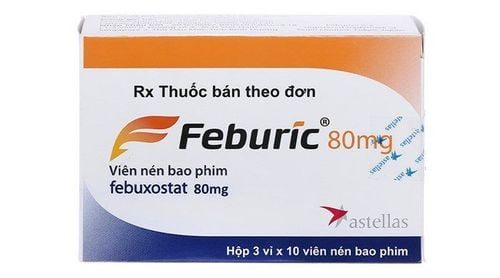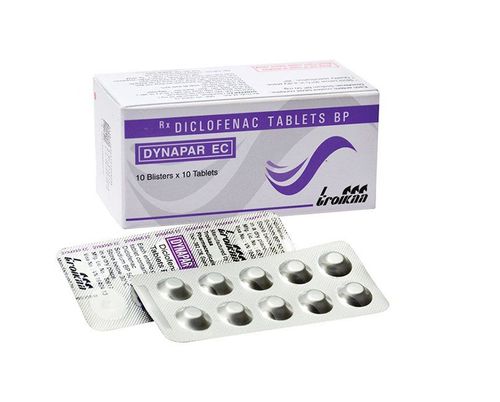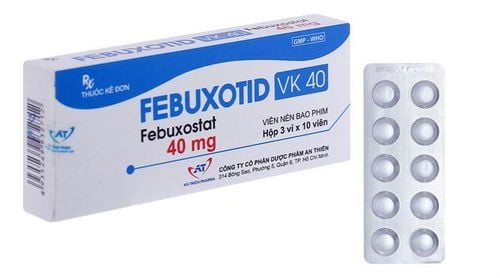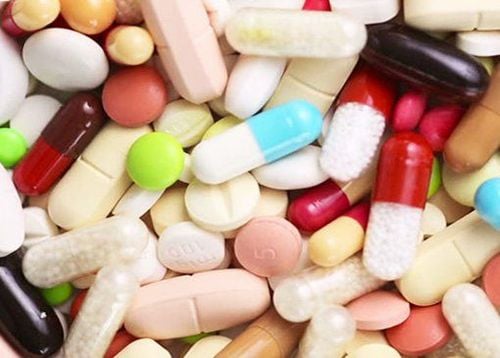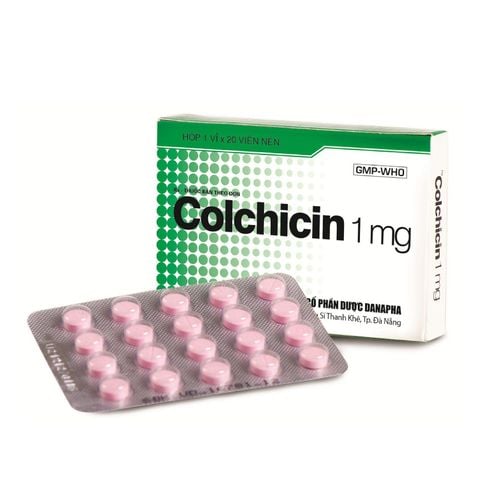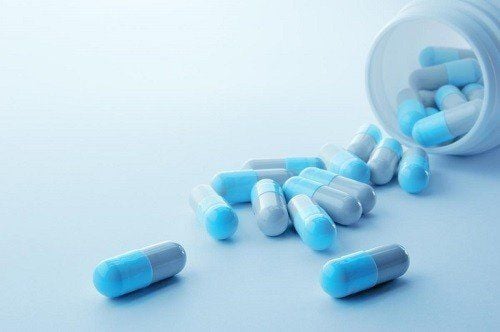This is an automatically translated article.
Probenecid is a drug that increases the excretion of uric acid in the urine. At the same time, the drug also has a good effect in reducing the concentration of uric acid in the serum. So what is Probenecid?1. What is Probenecid? The effect of the drug Probenecid
The drug Probenecid has an international generic name: Probenecid. Probenecid belongs to a group of drugs that increase uric acid excretion.
Dosage form is:
Probenecid 500 mg tablets; Film coated tablets 500 mg. Probenecid drug effect: Probenecid drug is effective in preventing gout and acute gouty arthritis. Probenecid belongs to the group of uricosuric drugs. The drug helps the kidneys excrete uric acid and reduces the concentration of uric acid in the body. When uric acid levels in the blood are too high, crystals form in the joints, causing gout.
Probenecid is sometimes used together with penicillin antibiotics (eg, penicillin, ampicillin, nafcillin) to increase blood levels of the antibiotic. This increase makes antibiotics more effective in treating certain infections. Probenecid works by reducing the kidneys' ability to remove antibiotics from the body. Probenecid should not be used in the treatment of children under 2 years of age.
1.1. Pharmacodynamics of the drug Probenecid Probenecid is a derivative of sulfonamides, with uric acid excretion properties, inhibiting the renal tubules from secreting some weak organic acids (such as penicillins and some beta-lactam antibiotics). Probenecid has the ability to competitively inhibit the active reabsorption of uric acid in the proximal tubule, thus increasing the excretion of uric acid in the urine, and at the same time, reducing uric acid levels in the blood. Active ingredient Probenecid can reduce or prevent urate deposition, tophi formation and chronic changes in joints; promotes dissolution of existing urate deposits and after several months of treatment, the number of acute gout attacks decreases. In healthy subjects, active substance Probenecid did not affect the glomerular filtration rate nor tubular reabsorption of normal components of urine such as glucose, arginine, urea, sodium, potassium or phosphate. Active ingredient Probenecid is used to support antibiotic therapy, increasing the concentration of some antibiotics (such as penicillin, some cephalosporin antibiotics) in the blood and prolonging the duration of action. competitive inhibition of weak organic acid secretion in the proximal and distal tubules. In addition, the active substance Probenecid also has the ability to inhibit the transport of many endogenous drugs and compounds in the kidney and/or bile, as well as transport into and out of the cerebrospinal fluid. Levels of 5-HIAA (5-hydroxyindoleacetic acid), homovanillic acid (HVA) increased in the cerebrospinal fluid after treatment with Probenecid. Because of this effect, Probenecid has been used to diagnose Parkinson's syndrome and psychiatric disorders such as depression.
1.2. Pharmacokinetics of Probenecid Absorption After oral administration, Probenecid is rapidly and almost completely absorbed. Distribution ability, Probenecid drug has a strong ability to bind to plasma proteins (75 - 90%). Concentrations in the cerebrospinal fluid reach about 2% of the drug plasma concentration. Probenecid crosses the placenta. Metabolism ability, Probenecid drug is slowly metabolized in the liver to monoacyl glucuronide derivatives, 2 monohydroxylated derivatives, 1 carboxylated derivative and 1 N-propyl reducing derivative. These metabolites of Probenecid still retain an active part that increases the ability to eliminate uric acid. Elimination ability, after oral administration of Probenecid at a therapeutic dose of 2 g, the plasma half-life of probenecid ranges from 4 to 17 hours. The half-life decreased when the therapeutic dose was reduced from 2 g to 500 mg. Probenecid is almost completely reabsorbed in the proximal tubule under acidic urine pH. Conversely, the ability to alkalize the urine reduces Probenecid reabsorption. Although this also increases drug excretion, the effectiveness of Probenecid is not significantly reduced.
2. Indications of Probenecid
Treatment of hyperuricemia in the blood for gout (in chronic arthritis and gout with tophi) in the chronic stage. Treatment of hyperuricemia secondary to other causes such as following concomitant use of diuretics: furosemide, thiazide, ethacrynic acid, pyrazinamide or ethambutol (except for secondary causes caused by cancer chemotherapy) , radiation therapy, cancer disease). Adjunct to antibiotic therapy to increase and prolong plasma drug concentrations in limited cases, such as the combination of Probenecid with the antibiotic Amoxicillin for the treatment of uncomplicated and non-penicillinase-sensitive gonococcal infections; in combination with the antibiotic cefuroxime for penicillinase-producing gonococcal disease, with cefoxitin for the outpatient treatment of acute pelvic inflammatory disease, with penicillin G procaine in the outpatient treatment of neurosyphilis. Prevention of nephrotoxicity caused by Cidofovir.
3. Usage and dosage of Probenecid
3.1. How to use Probenecid Drug Probenecid is used orally, during meals to reduce irritation in the gastrointestinal tract. During treatment with Probenecid, adequate fluid should be rehydrated to ensure diuresis and alkaline urine pH should be maintained. The therapeutic dose of Probenecid should be adjusted according to the individual response and tolerability. For children under 6 years old, you need to crush tablets containing Probenecid, then mix with yogurt or sugary liquid solutions to make it easier for children to take or use the medicine. 3.2. Dosage of Probenecid 3.2.1. For adults Treatment of hyperuricemia in gout:
When the exacerbation is over, start with a low treatment dose of 250 mg x 2 times/day for the first week to avoid causing another exacerbation, then increase to 1 Probenecid 500mg tablet twice a day. If the therapeutic effect is not achieved, the doctor may gradually increase the dose by 500 mg every 4 weeks until the maximum dose of 2 g / day is reached. In the absence of an acute gout attack within 6 months of initiating treatment, the dose may be reduced by 500 mg every 6 months until the minimum dose that controls uric acid levels in the blood is reached and treatment is continued. probenecid at this dose level. In combination with beta-lactam antibiotic therapy:
The usual dose of Probenecid is 1 tablet of Probenecid 500mg/time x 4 times/day. Recommended dose for the treatment of uncomplicated gonococcal infections caused by susceptible strains of Neisseria gonorrhoeae that do not secrete penicillinase: Take 1g of Probenecid with 3g of Amoxicillin as a single dose, then continue with Doxycycline 100 mg x 2 times/day x 7 days. Recommended dose for the treatment of uncomplicated gonococcal infections caused by penicillinase-producing susceptible strains of Neisseria gonorrhoeae: 1g of Probenecid with 1g of Cefuroxime as a single dose, then continue with Doxycycline 100 mg x 2 times/day x 7 days. Recommended dose for the treatment of acute pelvic infection: Take 1g of Probenecid in combination with 2g of cefoxitin intramuscularly as a single dose, then continue to use Doxycycline 100 mg twice daily for 10-14 days. Recommended dose for the treatment of neurosyphilis: Take 1 tablet Probenecid 500mg x 4 times/day in combination with procaine penicillin G 2.4 million IU/day intramuscularly for 10 to 14 days, then intramuscularly. single penicillin benzathine 2.4 million IU once a week for the next 3 weeks without probenecid. Prophylaxis of nephrotoxicity caused by Cidofovir:
Take 2g of Probenecid 3 hours before infusion of Cidofovir and repeat the therapeutic dose of 1g of Probenecid 2 and 8 hours after the end of the infusion of Cidofovir (total probenecid dose is 4g). 3.2.2. For children Probenecid is only indicated for the treatment of children 2 years of age and older in combination with beta-lactam antibiotic therapy. Treatment dose for children from 2-14 years old: Initially 25mg/kg/day, divided into 4 times, then increased to 40mg/kg/day, divided into 4 times. Children weighing 50 kg or more and children over 15 years of age can receive the same therapeutic doses as adults.
4. Undesirable effects when using Probenecid
Common undesirable effects such as headache, loss of appetite, nausea, vomiting, sore gums, feeling dizzy, increased frequency of urination during the day. Rare adverse effects such as anaphylaxis with fever, dermatitis, rash, urticaria, skin rash, very rarely anaphylaxis or Stevens-Johnson syndrome. In the event of an anaphylactic reaction when using the drug, you need to immediately stop using Probenecid. If an anaphylactic reaction occurs when Probenecid is used in combination with a penicillin-class antibiotic and the cause cannot be attributed to either drug, the use of both drugs must be stopped immediately. Probenecid increases the concentration of uric acid in the renal tubules, so it may promote the formation of urate stones in some people with gout accompanied by renal colic, pain along the waist, and bloody urine. This phenomenon occurs mainly at the beginning of treatment with Probenecid . To prevent this risk, you need to maintain diuresis with alkaline urine pH (sufficient fluid rehydration 2 - 3 liters/day, if necessary, add sodium bicarbonate or potassium citrate) to reduce the likelihood of formation. urate stones.
5. Probenecid drug interactions
Avoid combining Probenecid with Ketorolac. The reason is that this combination may increase the toxicity of Ketorolac on the kidneys, gastrointestinal tract and hematology. When combined with the drug Methotrexate may increase blood levels and toxicity of Methotrexate. Increased effects and toxicity of some other drugs: Probenecid increases plasma concentrations, thereby increasing the effects and toxicity of antibiotics of the Carbapenem group, Cephalosporin antibiotics, Dapson, and other drugs. non-steroidal anti-inflammatory drugs (NSAIDs), quinolone antibiotics, sulphamide group with hypoglycemic effect, sodium benzoate, derivatives of theophylline, zidovudin, zalcitabine. Reduces the effect of Probenecid: When Probenecid is combined with high-dose Aspirin or salicylates derivatives, the uric acid elimination effect of each drug is reduced. Some drugs have the ability to increase blood uric acid such as diuretics, diazoxide, pyrazinamide, alcohol. The reason is that when together with Probenecid, it is necessary to increase the dose of Probenecid to effectively lower uric acid in the blood. Cancer drugs also increase serum uric acid levels, however, when used in combination with Probenecid, the risk of kidney disease caused by uric acid increases. Therefore, Probenecid should not be used in cancer patients undergoing chemotherapy.
6. Contraindications when using Probenecid
Coagulation dysfunction; Kidney stones, especially urate stones; Concomitant use with aspirin or salicylates; Acute gout attack; Acute porphyria metabolism disorder; Children 2 years and under; Renal failure with creatinine clearance < 30mL/min; Hyperuricemia secondary to blood malignancies.
7. Some notes when using Probenecid
7.1. General Precautions when using Probenecid Use caution when using Probenecid in people with a history of peptic ulcers. When Probenecid is started, uric acid stones can form due to increased uric acid levels in the renal tubules, leading to hematuria, renal colic, and pain in the ribs and vertebrae. Ensure adequate fluid resuscitation (2–3 L/day) and alkalinize the urine if initial plasma uric acid levels are high. Should not be combined with penicillin group antibiotics for people with renal failure. Probenecid should be discontinued immediately if hypersensitivity reactions occur. Start using Probenecid when the acute gout attack is in remission. The frequency of acute gout attacks may increase gradually during the first 6-12 months of drug use. Continue using probenecid and colchicine or other anti-inflammatory agents to control acute attacks if they occur during probenecid therapy. Probenecid is not effective in patients with renal failure with ClCr < 30mL/min. Probenecid may cause a false positive in the urine glucose test using the Benedict method. Probenecid is a drug that increases the excretion of uric acid in the urine. At the same time, the drug also has a good effect in reducing the concentration of uric acid in the serum. To ensure the effectiveness of treatment, as well as avoid unwanted side effects, patients need to use prescription drugs or consult a doctor, professional pharmacist.
Follow Vinmec International General Hospital website to get more health, nutrition and beauty information to protect the health of yourself and your loved ones in your family.
Please dial HOTLINE for more information or register for an appointment HERE. Download MyVinmec app to make appointments faster and to manage your bookings easily.




